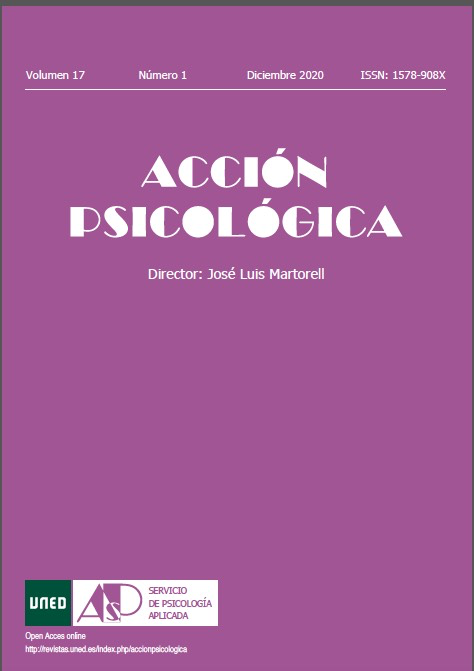Assessing the Influence of Reversed Items and Force-Choice on the Work and Meaning Inventory [Evaluación de la influencia de los ítems invertidos y de elección forzosa en el Inventario de trabajo significativo]
DOI:
https://doi.org/10.5944/ap.17.1.27330Palabras clave:
work, meaning at work, acquiescence, forced-choice items [trabajo, trabajo significativo, aquiescencia, ítems de elección forzosa]Resumen
Abstract
Response biases are issues in inventories in positive organizational psychology. The study aims to control the response bias in the assessment of meaning of work through two methods: reversed key items and forced-choice format. The sample consisted of 351 professionals; women constituted 60.0 % of the sample. The participants answered two versions of the instrument for meaning of work: Likert-type items and forced-choice. For both versions, the unifactorial model was the most appropriate for the data available. The results indicate that the random intercepts model fit the Likert data (CFI = .92), as well as the forced-choice model (CFI = .97). Besides, the latent dimension of the forced-choice version did not correlate with acquiescence index (r < .08; p > .05), and approximately 20 % of the variance of the items might be due to the method (Likert or forced-choice). The present study illustrates the importance of response bias control in self-report instruments.
Resumen
Los sesgos de respuesta son problemas en los inventarios de la psicología organizacional positiva. El estudio tiene como objetivo controlar el sesgo de respuesta en la evaluación del trabajo significativo a través de dos métodos: ítems clave invertidos y formato de elección forzosa. La muestra estuvo formada por 351 profesionales; las mujeres constituyeron el 60.0 % de la muestra. Los participantes respondieron dos versiones del instrumento de significado del trabajo: ítems tipo Likert y elección forzosa. Para ambas versiones, el modelo unifactorial fue el más apropiado para los datos disponibles. Los resultados indican que el modelo de intersecciones aleatorias se ajusta a los datos Likert (CFI = .92), así como al modelo de elección forzada (CFI = .97). Además, la dimensión latente de la versión de elección forzada no se correlacionó con el índice de aquiescencia (r < .08; p > .05), y aproximadamente el 20 % de la varianza de los ítems podría deberse al método (Likert o forzado). elección). El presente estudio ilustra la importancia del control del sesgo de respuesta en los instrumentos de autoinforme.
Descargas
Citas
Akin, A., Hamedoglu, M. A., & Kaya, C. (2013). Turk¬ish Version of the Work and Meaning Inventory (WAMI): Validity and Reliability Study. Journal of European Education, 3(2), 11–16.
Allan, B. A. (2017). Task Significance and Meaningful Work: A longitudinal study. Journal of Vocational Behavior, 102, 74–182. https://doi.org/10.1016/j.jvb.2017.07.011.
Billiet, J. B. & McClendon, M. J. (2000). Modeling Ac¬quiescence in Measurement Models for Two Bal¬anced Sets of Items. Structural Equation Modeling, 74, 608–628. https://doi.org/10.1207/S15328007SEM0704.
Brown, T. A. (2015). Confirmatory Factor Analysis for Applied Research (2nd ed.). The Guilford Press.
Brown, A. & Maydeu-Olivares, A. (2012). How IRT Can Solve Problems of Ipsative Data in Forced-Choice Questionnaires. 2013, American Psycho¬logical Association,18(1) 36–52. https://doi.org/10.1037/a0030641.
Brown, A. & Maydeu-Olivares, A. (2018). Modeling Forced-Choice Response Formats. In P. Irwing, T. Booth, & D. Hughes (Eds.), The Wiley Handbook of Psychometric Testing (pp. 523–570). Wiley-Blackwell.
Farrell, A. M. (2010). Insufficient Discriminant Valid¬ity: A Comment on Bove, Pervan, Beatty, and Shiu (2009). Journal of Business Research, 63(3), 324–327. https://doi.org/10.1016/j.jbusres.2009.05.003
Finch, J. D. (2014). The Dimensionality of the Work and Meaning Inventory [Doctoral Thesis, University of Johannesburg, South Afric]. UJContent. http://hdl.handle.net/10210/12007
Guenole, N., Brown, A., & Cooper, A. J. (2018). Forced-Choice Assessment of Work-Related Maladaptive Personality Traits: Preliminary Evidence From an Application of Thurstonian Item Response Model¬ing. Assessment, 25(4), 513–526. https://doi.org/10.1177/1073191116641181
Jena, L. K., Bhattacharyya, P., & Pradhan, S. (2019). Am I Empowered through Meaningful Work? The Moderating Role of Perceived Flexibility in Con¬necting Meaningful Work and Psychological Em-powerment. IIMB Management Review, 31(3), 298–308. https://doi.org/10.1016/j.iimb.2019.03.010
Leonardo, M. G. L., Pereira, M. M., Valentini, F., Freitas, C., & Damásio, B. (2019). Adaptação do Inventário de Sentido do Trabalho (WAMI) para o contexto brasileiro [Adaptation of Work and Meaning Inventory (WAMI) to the Brazilian context]. Revista Brasileira de Orientação Profissional, 20(1), 79–89. http://dx.doi.org/10.26707/1984-7270/2019v20n1p79
Maydeu-Olivares, A. & Coffman, D. L. (2006). Random Intercept Item Factor Analysis. Psychological Methods, 11, 344–362. https://doi.org/10.1037/1082-989X.11.4.344.
Muthén, L. K. & Muthén, B. O. (2010). Mplus: Statistical Analysis with Latent Variable. User’s Guide. Muthén & Muthén.
Rose, N. & Steger, M. F. (2017). Führung, die Sinn macht. Organisationsentwicklung–Zeitschrift für Unternehmensentwicklung und Change Management (04), 41-45.
Steger, M. F., Dik, B. J., & Shim, Y. (in press). Assessing Meaning and Satisfaction at Work. In S. J. Lopez (Ed.), The Oxford Handbook of Positive Psychology Assessment (2nd Ed.). Oxford University Press.
Steger, M. F., Dik, B. J., & Duffy, R. D. (2012) Measuring Meaningful Work: The Work and Meaning Inventory (WAMI). Jornal of Career Assessment, 20(3) 322–337. https://doi.org/10.1177/1069072711436160.
Valentini, F. (2017). Influência e controle da aquiescência na análise fatorial. Avaliação Psicológica, 16 (2), 120-251. https://doi.org/10.15689/ap.2017.1602.ed.
Valentini, F. & Damásio, B. F. (2016). Variância Média Extraída e Confiabilidade Composta: Indicadores de Precisão [Average Variance Extracted and Composite Reliability: Reliability Coefficients]. Psicologia: Teoria e Pesquisa, 32(2). https://doi.org/10.1590/0102-3772e322225
Descargas
Publicado
Cómo citar
Número
Sección
Licencia
La revista Acción Psicológica se publica bajo licencia Creative Commons Reconocimiento – NoComercial (CC BY-NC). Las opiniones y contenidos de los artículos publicados en Acción Psicológica son de responsabilidad exclusiva de los autores y no comprometen la opinión y política científica de la revista. También serán responsables de proporcionar copias de los datos en bruto, puntuaciones, y, en general, material experimental relevante a los lectores interesados.
Copyright Note
Acción Psicológica is published under Creative Commons Attribution-Non Commercial (CC BY-NC). The opinions and contents of the articles published in Acción Psicológica are responsibility of the authors and do not compromise the scientific and political opinion of the journal. Authors are also responsible for providing copies of the raw data, ratings, and, in general, relevant experimental material to interested readers.











